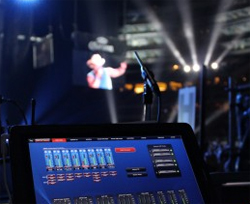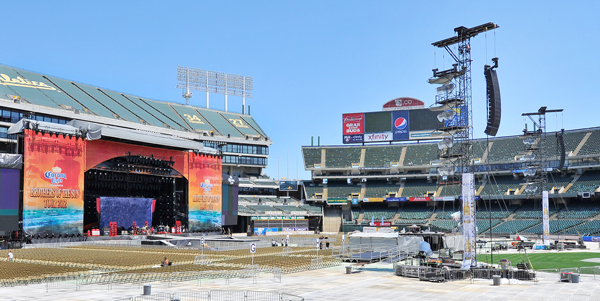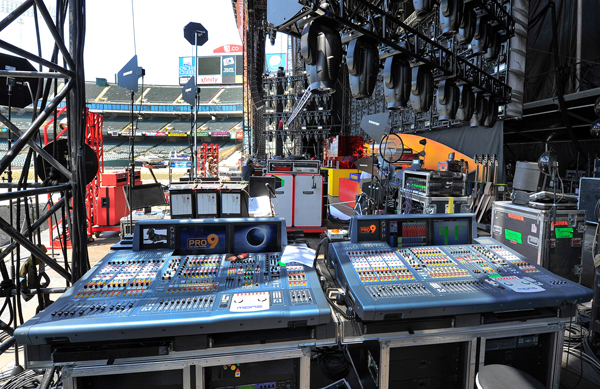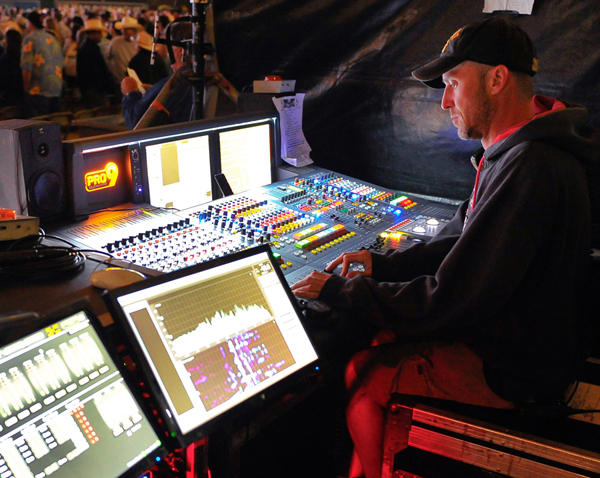
The Right Thing
Typically there are three X-Line line array columns hanging on each side.
Spanning 20 deep for mains, another 20 deep for the sub hang, and 16 deep for the out hang per side, the system is further buttressed by delay towers weighing-in with another 16 boxes apiece.
“I took down 32 boxes last year,” Mills relates. “They were just overkill so I sent them home. David (Haskell) called and asked me if I was sure it was a good decision.
“I told him absolutely, we’ll save $100,000 by cutting a truck from the tour, the inventory could be used back at the shop for something else, and bottom line, with line arrays more is not always better.
“The correct amount is always the right thing. Just because you aim more speakers at a specific spot doesn’t make them sound better.”
Within this year’s configuration, the subwoofer hangs were placed upstage behind the mains, and then the side hangs were brought in a little closer according to edicts established by Mills’ modeling.
His methodology takes aim at creating a uniform wavefront of low-end throughout the venue.

With his delay techniques, the design produces an acoustically accurate equilateral triangle. That is, all three of the hangs on each side are equally spaced acoustically and exist around a common point that steers low-end energy out away from center around 45 degrees.
The ensuing low-end locks-in and remains punchy all the way across the room horizontally, and also – because of the 45-degree steering – minimizes the power alley.
A little vertical steering is provided as well to the sub hangs via “tapering” delay tricks that effectively allow the arrays to be aimed lower or higher as required, turning what would be a doughnut-shaped coverage pattern (with a center “hole”) into more of a pancake-shaped one that provides more even dispersion.
Digital Advantages
Three Midas PRO9 consoles are out on the tour. For monitors, Brian “Opie” Baxley manages Sennheiser in-ear mixes for the band from his PRO9, while Phill Robinson dedicates all of his PRO9 orchestrations toward keeping Kenny Chesney within his preferred in-ear environment, which is provided by a Shure PSM1000 system.
Out front, Bryan Vasquez is the man in charge from behind a third PRO9.
“The engineers all have longstanding analog histories,” Mills says, providing a brief biographical console sketch for each: “Bryan was seen regularly with an XL3, and our monitor guys went through what I believe was a progression favoring 5Ds and XL8s. The PRO9s have been amazing in this application, as they respond and sound just like you’d think a classic Midas would, only now you get all the advantages of digital too.”
Chesney’s mic handling and technique is similar in many aspects to rap artists. He cups it at the capsule, puts his thumbs over the end, and then holds it about 18 inches away. This tour marked a change in his microphone choice, with Mills fulfilling the input list with a Shure Axient AXT200 wireless transmitter sporting a KSM9HS capsule.
“One of the most formidable challenges we experience during the act is when Kenny flies out over the audience perched on a swing,” Mills explains. “At this moment practically everything around him is made of steel, and we’re supposed to blow RF to him up to 300 feet away while he’s in the middle of the stadium and not have drop-outs. In the past we were constantly scouring the earth for the world’s most powerful antennas, fitting him with two beltpacks – one on and the other on standby. It was unbelievable the hoops we were jumping through.
“This year I said ‘I’m done with this,’ and decided we had to have the best of the best. It took a little convincing because the Axient system isn’t exactly what you’d call cheap, but we achieved our goals. So far this year we’ve taken zero hits to his microphone and zero hits to his beltpack, so it’s been worth every dollar spent.”


